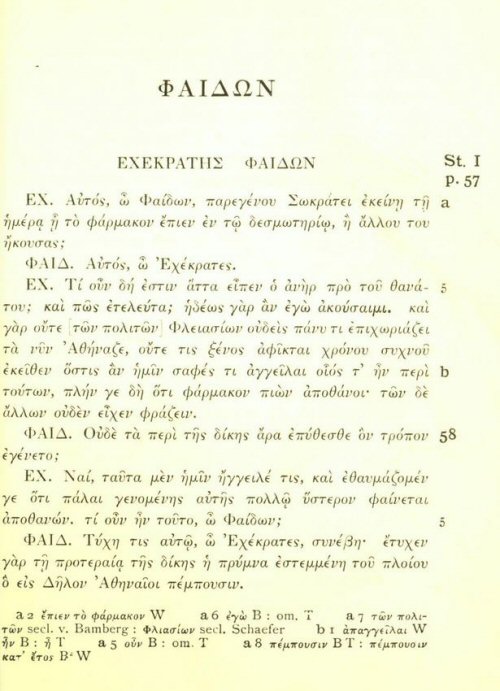THE PERIOD OF SCHOOLS
Plato. The Academy. Four Theories
The
development
of Perseus Digital Library
began in 1987.
Yale University Press published CD-ROM versions in
1992 and 1996.
In
1995,
the Perseus Digital Library went online.
(A CD-ROM is an optical disk for data storage and retrieval. They had a use
before everything went online.)
Before 1995, we relied on books mostly in physical libraries.
Here is a page from a book that contains the first two tetralogies of Plato's dialogues.
It is open to the
Phaedo.
 Platonis Opera,
Tomvs I. Tetralogia I-II Continens, edited by John Burnet. Oxford
University Press, 1900.
Platonis Opera,
Tomvs I. Tetralogia I-II Continens, edited by John Burnet. Oxford
University Press, 1900.
"Yourself, Phaedo," the text reads, "were you with Socrates on the day when he drank the poison
in prison (αὐτός, ὦ Φαίδων, παρεγένου Σωκράτει ἐκείνῃ τῇ ἡμέρᾳ ᾗ τὸ φάρμακον
ἔπιεν ἐν τῷ δεσμωτηρίῳ)"
I bought the book in graduate school.
(The yellow bottom left is from spilt coffee.)
It was expensive, especially for a graduate student in philosophy, but now, thanks to donations,
the Greek texts of Plato's dialogues are online freely available to all in the Perseus Digital Library.
A new edition came out in 1995.
Platonis Opera, Tomus. I. Tetralogias I-II
Continens. Edited by E. A. Duke, W. F. Hicken, W. S. M. Nicoll, D. B.
Robinson & J. C. G. Strachan). Oxford University Press.
"[T]he last of the Pythagoreans... were Xenophilus from the Thracian
Chalcidice, Phanton of Phlius, and Echecrates, Diocles and Polymnastus, also
of Phlius, who were pupils of Philolaus and Eurytus of Tarentum"
(Diogenes Laertius,
Lives of the Philosophers VIII.46).
"Phaedo was a native of Elis, of noble family, who on the fall of that city was
taken captive and forcibly consigned to a house of ill-fame. But he ...
contrive[d] to join Socrates’ circle, and in the end Socrates induced Alcibiades
or Crito with their friends to ransom him; from that time onwards he studied
philosophy as became a free man"
(Diogenes Laertius,
Lives of the Philosophers
II.105).
Plato nowhere explains what he is trying to
accomplish in particular dialogues or why he writes at all,
but it is easy to get the impression
that his use of the character Socrates in the middle dialogues marks a new phase
in his effort to understand what the historical Socrates got right about
the good life.
Socrates continues as the main character, but he
no longer just asks questions.
Now he argues for the views that have come to be known as
• The Theory of Recollection
• The Theory of Forms
• The Tripartite Theory of the Soul
• The Theory of Justice.
We are going to look at these theories in the Meno, the Phaedo, and the Republic. In these theories, although the character Socrates gives them, he speaks for Plato.
• Meno
Meno is visiting Athens from Thessaly (in the north of Greece). He asks Socrates how virtue is acquired.
In the course of the conversation, Socrates introduces the Theory of
Recollection.
• Phaedo
The dialogue is set in Phlius, a Greek city about 75 miles west of Athens.
Phaedo
is on
his way home to Elis, which is about 125 miles further west. He had been with Socrates on his last day. Echecrates is a Pythagorean.
He asks Phaedo to retell the
conversation Socrates had with his friends before his execution. In this conversation, as part of his explanation
for why the φιλόσοφος does not fear death, Socrates introduces the
Theory of Forms.
•
Republic
Glaucon and Adeimantus (Plato's brothers) challenge Socrates to show that justice pays and that the
just are happier than the unjust. Socrates introduces the Tripartite
Theory of the Soul as part of his explanation of what justice is in an individual, and he goes on
to argue that justice does pay and that those whose souls are just are happier than those whose souls are not just.
The Republic is Plato's second longest dialogue. Only the Laws (a late dialogue) is longer.
Sets of Selected Texts
The following sets of selected texts are grouped by topics.
This makes the reading more manageable for a semester course, but the absence of context can make the import of the texts difficult to appreciate. It helps to read the lectures first.
• Theory of Recollection
Meno complains that he cannot answer Socrates' what is virtue question and that the problem is with the question,
not with him. In
reply, in the Theory of Recollection, Socrates argues
that we can recollect the answer because it is in the soul before the soul enters the body.
• Theory of Forms
Socrates argues that there are objects he calls "forms"
(είδη), that they are unchanging, that they are grasped in reason,
and that the body is an obstacle to grasping them.
• Tripartite Theory of the Soul
Socrates argues that the soul has three parts (reason, spirit,
and appetite) and that each can give rise to desire. This is inconsistent with the
intellectualism about desire in the Protagoras.
• Justice in a City and an Individual
Socrates argue for a view of justice. In a "city" (πόλις), it is the organization that best achieves the purpose for which human beings come together to live
in cities. In an individual human being, it is the appropriate
organization of the three parts of the soul.
• The Just Life is Better
Socrates argues that the just life is better than the unjust life.

